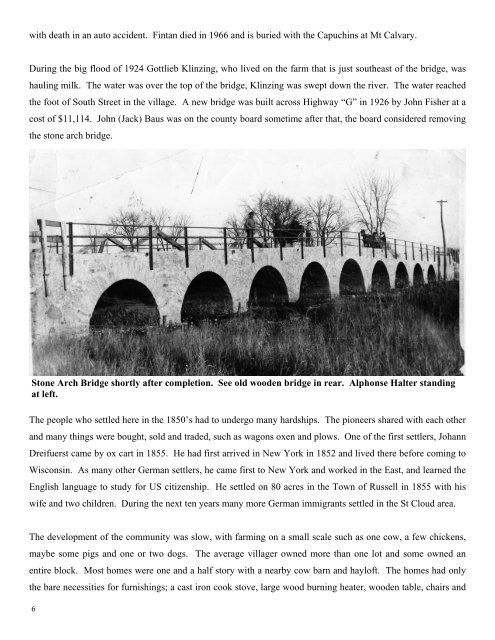with death in an auto accident. Fintan died in 1966 and is buried with the Capuchins at Mt Calvary.During the big flood <strong>of</strong> 1924 Gottlieb Klinzing, who lived on the farm that is just southeast <strong>of</strong> the bridge, washauling milk. The water was over the top <strong>of</strong> the bridge, Klinzing was swept down the river. The water reachedthe foot <strong>of</strong> South <strong>St</strong>reet in the village. A new bridge was built across Highway “G” in 1926 by John Fisher at acost <strong>of</strong> $11,114. John (Jack) Baus was on the county board sometime after that, the board considered removingthe stone arch bridge.<strong>St</strong>one Arch Bridge shortly after completion. See old wooden bridge in rear. Alphonse Halter standingat left.The people who settled here in the 1850’s had to undergo many hardships. The pioneers shared with each otherand many things were bought, sold and traded, such as wagons oxen and plows. One <strong>of</strong> the first settlers, JohannDreifuerst came by ox cart in 1855. He had first arrived in New York in 1852 and lived there before coming to<strong>Wisconsin</strong>. As many other German settlers, he came first to New York and worked in the East, and learned theEnglish language to study for US citizenship. He settled on 80 acres in the Town <strong>of</strong> Russell in 1855 with hiswife and two children. During the next ten years many more German immigrants settled in the <strong>St</strong> <strong>Cloud</strong> area.The development <strong>of</strong> the community was slow, with farming on a small scale such as one cow, a few chickens,maybe some pigs and one or two dogs. The average villager owned more than one lot and some owned anentire block. Most homes were one and a half story with a nearby cow barn and hayl<strong>of</strong>t. The homes had onlythe bare necessities for furnishings; a cast iron cook stove, large wood burning heater, wooden table, chairs and6
enches. The women wore calico dresses and the men wore blue denim work clothes. Men wore cloth suits onSunday, which cost about five dollars.The settlers on the farms located outside the village <strong>of</strong>ten moved to the village when they aged. The secondgeneration <strong>of</strong> these first settlers came to be prominent business people <strong>of</strong> <strong>St</strong> <strong>Cloud</strong>. Some <strong>of</strong> the earlybusinesses were; Nicholas Lanzer, Charles Resimus General <strong>St</strong>ore, Rudolph Goeb shoemaker, Burkard andMarsellus Goeb stone masons, Baltes Pickart blacksmith, Johann and Joseph Schmitt carriage builders, FranzTimm saddlery, Lorenz and Joseph Zentgraff stone masons, <strong>And</strong>rew Darnieder’s store, Hochrein’s tavern, NickMeyer’s tavern, Braun’s store, J. H. Coolidge’s store, Northwestern Hotel, Central House, Goedert’s tavern.Land was cleared for farming, huge trees had to be cut down during the winter, and the soil was worked roughlyin the spring, the seeds were spread between the tree stumps and stones to be harvested in fall. The endlessforest had a rich game population <strong>of</strong> all kinds to provide meat for whoever owned a rifle. In spite <strong>of</strong> all thehardships, the people were cheerful, ready to help each other. Wheat was a principle crop in the pioneer daysproviding bread to the table. To the north were Benedict and Heinrich Wehner, George Achter, AdrianDreifuerst, Johann Dreifuerst, Valentin Keller, Wilhelm Bergs, <strong>St</strong>ephen Zieher, August Klinzing, JohannLimberg, Johann Schmitt, Peter Mertes, and Johann Pauly. In the south worked Johann Bittner, August Neder,Nicholas Klinzing, Johann Entringer, Peter Render, Mathias Leon, Peter Burg, and Johann Hochrein.Some other early settler names were Baus, Bittner, Deitz, Keach, Keller, Voelker, Wolf, Ewald, Mihm, Enders,Feldner, Will, Kane, Pieper, Beitzer, Lorge, Goebel, Sattler, Juergens, Reuder, H<strong>of</strong>fman, <strong>St</strong>effes, Hursh,Yamler, Berens, Hindelaug, and Moeller.When the new century <strong>of</strong> 1900 started, the pioneer days were thought to be at an end. The second generationhad taken over and the quality <strong>of</strong> living was getting better. Homes were improved, yards showed pride. Horseswere in fine shape, covered buggies came into general use and the roads were improved.Clark and Thorp’s Sawmill and the Lumber BusinessWhen F. Clark and Thorp (the streets adjacent to the sawmill are named after them) bought the four-acre parcelin the center <strong>of</strong> the village on April 2, 1869 for fifty dollars from Henry Moersch and Michael Blonien, theybuilt a sawmill and lumberyard to supply all building needs. They produced ship lumber, wagon lumber,broom handles, bed slats, bent bob runners, and cutter stuff as listed on their picture advertisement. A railroadspur was built into the yard as indicated by the 1893 village map. The sawmill burned around 1881, thelumberyard was kept there for a period <strong>of</strong> time after that.7


